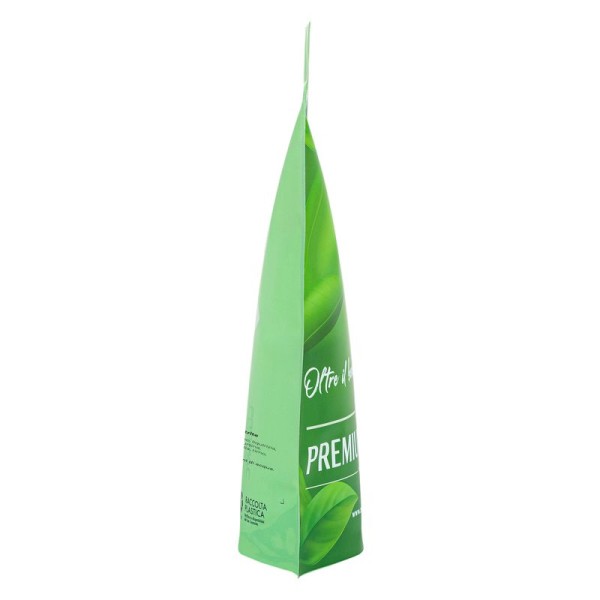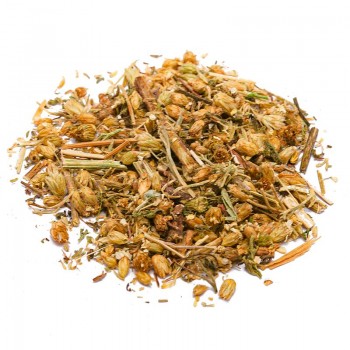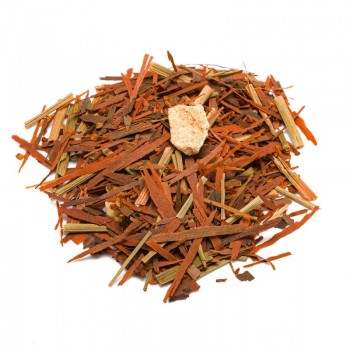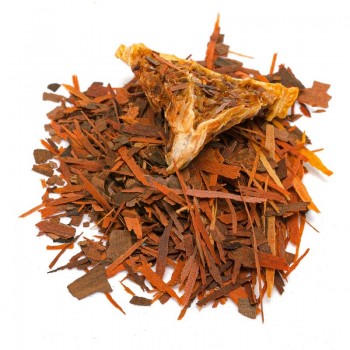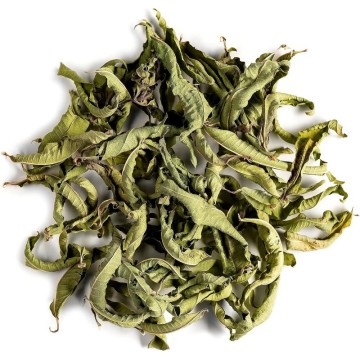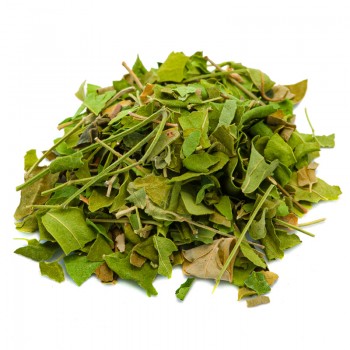The blend of medicinal plants to fight arthritis , was conceived with herbs designed to combat this disorder, thanks to their natural anti-inflammatory qualities.
Analyzing the plants that make up this mixture we find spirea, lime, ash and birch: ingredients known in herbal medicine, to counteract inflammation related to arthritic problems.
We also find herbs such as yarrow, mint and myrtle that have soothing properties, also useful for other ailments. An infusion based on these herbs greatly helps our body to fight the negative effects of arthritis.
Herbs against arthritis: properties and benefits
The anti-inflammatory herbal tea contains substances that can help to calm the pain caused by different types of arthritis (osteoarthritis or rheumatoid arthritis).
These are natural remedies that help manage mild symptoms, with their properties. We know, in fact, that arthritis is a chronic condition, accompanied by joint pain that can be relieved with herbal treatments.
These are plants with a high content of antioxidants and substances useful for reducing inflammation and tissue damage.
Spirea ulmaria is a fundamental ingredient of this anti-inflammatory herbal tea, for its active ingredients that are usually recognized in treating flu symptoms, joint pain and rheumatic.
In phytotherapy it is one of the most used natural remedies to soothe joint pain, thanks to flowers rich in salicin , vitamin C, mineral salts , flavonoids . Salicin, in particular, is an element that can relieve pain related to osteoarthritis and arthritis. With the advantage that its mucilages protect the stomach walls, compared to other more aggressive remedies.
Spirea salicin also helps as a natural analgesic to relieve pain such as tense, headache, toothache and joint pain.
Ash leaves are another useful element in the blend of herbs for arthritis, due to their richness in iron, copper, flavonoids and salicylic acid . They can be useful against rheumatism, also thanks to the presence of coumarins and flavonoids that give anti-inflammatory properties.
Licorice extracts are also known for their natural anti-inflammatory properties, effective in the herbal treatment of arthritis. The glycyrrhizin, contained in the plant, helps to block and relieve the inflammation typical of this pathology.
Other medicinal herbs useful for arthritis are elderberry and birch.
The elderberry plant makes available the qualities that counteract inflammation, due to the flavonoids and terpenes contained, and helps stimulate blood circulation against swelling, muscle pain and l numbness of the limbs.
Birch exerts a rubefacient action, that is, it draws the blood into the superficial layers of the skin and heats it. A useful property to naturally treat arthritis, osteoarthritis and rheumatism and sciatica.
Fir is another plant known for its ability to relieve muscle and joint pain, in its extracts. Traditionally it was used in herbal medicine to treat sciatica, cervical, rheumatism, arthritis and arthritis pains. Also for its ability to deflate the turgid parts and relax the muscles.
Myrtle is a plant historically used as a natural analgesic, which relaxes the muscles and provides relief in the case of arthritis pain.
A plant known for its effects on preventing the symptoms of arthritis is thyme, which has natural antioxidants and anti-inflammatories, also able to relax the muscles.
Chamomile is another plant that has been used for centuries for the treatment of joint pain, thanks to its compounds with anti-inflammatory action. These are phenolic compounds such as apigenin, quercetin, luteolin and patuletin ; their action reduces inflammatory cytokines and can help in the treatment of arthritis.
The dry flower part of the plant has historically been used to soothe rheumatic pain and inflammation.
Following the natural method to combat joint pain, these iningredients of the herbal blend for arthritis, the yarrow plant. Its anti-inflammatory characteristics are due to some antioxidants and volatile oils, and above all to the presence of derivatives of salicylic acid, and eugenol.
Mint is a useful herb for its analgesic and anti-inflammatory characteristics, suitable for the natural treatment of arthritis.
Origins and History of cultivation
In the blend of herbs to soothe the symptoms of arthritis, there are several medicinal plants that have been used in herbal medicine for centuries.
Most have been used in the past for their beneficial anti-inflammatory and pain relieving (analgesic) action:
Different plants are used individually, as well as in the mix created for anti-inflammatory herbal teas.
Most of the medicinal herbs in the arthritis blend have been in Europe forever, and today all ingredients are available dried and ready for infusion.
Plants and flowers
The components of the mixture for arthritis derive from medicinal plants or shrubs used in phytotherapy for their characteristics.
The Achillea millefolium plant, part of the Asteraceae family, is a perennial plant. It spreads easily, growing to about 1 meter in height, with aromatic leaves and white flowers. Originally from various continents, it was introduced in North America in colonial times.
The Birch or Betula belongs to the genus of the Betulaceae. The genus of the family includes about 40 species of trees and shrubs, the habitat of which is given by the northern cold regions. Birches display a white, flaking bark, useful in herbal medicine.
The Sambucus nigra is a shrub of the genus Sambucus in the Adoxaceae family. It grows in Europe and Western Asia, preferably in humid and sunny places, reaching a height of about 15 meters, in addition to a life of about 60 years.
The ash (Fraxinus ornus) , is a plant of the Oleaceae family. It reaches a maximum height of 8 meters, showing a smooth and greyish bark. Its leaves are green, the flowers white or slightly pink, and the fruit produces only one seed. It grows best in temperate climates, in humid woods and up to about 1500 meters above sea level.
The spirea or Spiraea is a perennial plant belonging to the Rosaceae family. Also known as spirea ulmaria or white spirea, it has Asian origins but soon spread throughout Europe, in humid and continental climates. It is a plant with a thin stem, which can reach 150 cm in height, showing white or pink flowers in the shape of a spiral (hence the name of the plant).
The licorice , from the botanical name of Glycyrrhiza glabra, is part of the Fabaceae family. It is a perennial plant native to southwestern Asia and the Mediterranean area. It is known for its roots, which give a sweet compound, glycyrrhizin. The licorice plant requires deep, fertile, moisture-rich soil to grow. Plant growth is slow at first, but it can become a weed.
The fir (Abies) is an evergreen plant belonging to the Conifer family. Of this genus there are at least 48-56 species of conifers of the Pinaceae family. They are found largely in mountain climates, North and Central America, Europe, Asia and North Africa.
myrtle (Myrtus communis) is an evergreen shrub of the Myrtaceae family. It is typical of the Mediterranean vegetation, but also widespread in North Africa, Western Asia, India. It shows a small stem, reaching about 3.5 meters in height at the most. It shows long, oval, glossy leaves, solitary and fragrant pink or white flowers.
The Matricaria chamomilla L., is part of the Asteraceae. At the level of officinal herb, it is present in two varieties: German chamomile (Matricaria recutita, or Chamomilla recutita) and Roman chamomile (Chamaemelum nobile), with a similar appearance. It gives flowers similar to daisies, with a sweet scent. They bloom from May to September, are collected and dried for herbal teas.
The bearberry plant is Arctostaphylos uva-ursi,a species of the genus Arctostaphylos and of the family Ericaceae. It is found in the regions near the Arctic Circle, and in the northern subarctic hemisphere (ursina because the bears are greedy for it).
mint (Mentha) is a perennial herb of the Lamiaceae family. Known for its aroma, it has a woody rhizome, oval and serrated leaves. The many species of mint have similar medicinal properties, thanks to the presence of menthol as a common component.
The Thymus vulgaris is an aromatic plant of the Lamiaceae family. It grows spontaneously in many Mediterranean countries, preferring light, well-drained, arid and rocky soils, and a warm, sunny climate. It shows a shrub with dense bushes, which can reach 20-30 cm in height. The stems are thin, the leaves are narrow, elongated and very fragrant, green and gray shades.
The lime tree is a plant of the genus Tilia - Tiliaceae family. It is mainly grown in the Tilia cordata Mill variety for therapeutic purposes. It is native to Europe and the Caucasus, and grows in hilly areas.
Nutritional values of the herbal blend for arthritis
The combination of herbs useful against inflammation and pain of arthritis and rheumatism, contain several active ingredients.
There are various flavonoids (quercetin, rutin, etc), other antioxidants, substances such as terpenes and coumarins , which inhibit the production of substances that promote inflammation.
An important element is the presence of salicylic acid, salicylates and salicin .
There are also vitamins and mineral salts, tannins, organic acids .
How to use herbs in anti-inflammatory herbal tea for arthritis
To prepare a cup of tea (250 ml), you will need about 3-5 grams of the herbal blend for arthritis.
Leave to infuse for 8 to 10 minutes in water at 100 ° C. before drinking the herbal tea.
Add honey or sugar if desired.
Herbal blend for arthritis: side effects and contraindications
Among the anti-inflammatory herbal teas, this blend has no major contraindications.
In any case, it is not recommended for those sensitive to certain medicinal herbs, with allergies or intolerances to individual ingredients.
It is recommended not to take the herbal tea for long periods and to respect the recommended doses, to avoid stomach pain, diarrhea and nausea. Due to the presence of substances that act on the musculoskeletal system, it is recommended to seek medical advice for those who already use anti-inflammatory drugs.
The presence of salicylic acid and other derivatives may require a medical opinion for those who take cardioaspirin and blood anticoagulants. The herbal tea is not recommended for pregnant and breastfeeding women.





